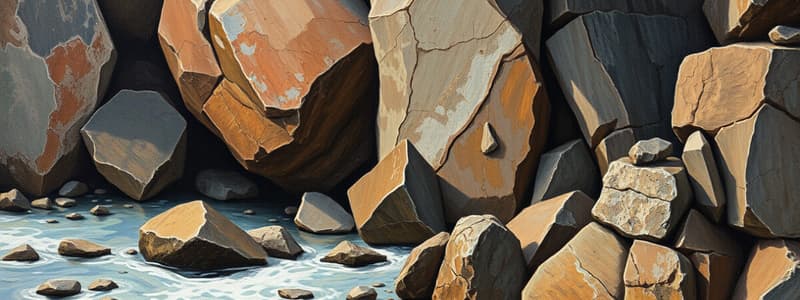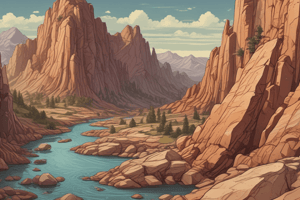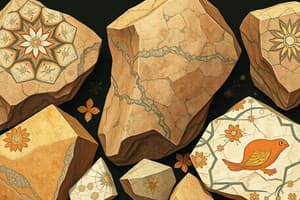Podcast
Questions and Answers
Which type of rock is formed from solidified molten material?
Which type of rock is formed from solidified molten material?
- Sedimentary Rocks
- Metamorphic Rocks
- Igneous Rocks (correct)
- None of the above
What type of igneous rock forms beneath the Earth's surface?
What type of igneous rock forms beneath the Earth's surface?
- Coal
- Granite (correct)
- Basalt
- Sandstone
Which process involves the movement of tectonic plates?
Which process involves the movement of tectonic plates?
- Erosion
- Weathering
- Tectonism (correct)
- Volcanism
What type of rocks are formed from the accumulation and compaction of mineral and organic particles?
What type of rocks are formed from the accumulation and compaction of mineral and organic particles?
What is the term for the breakdown of rocks into smaller particles?
What is the term for the breakdown of rocks into smaller particles?
Metamorphism is the transformation of rocks due to heat and pressure.
Metamorphism is the transformation of rocks due to heat and pressure.
Sulfides contain which elements?
Sulfides contain which elements?
___ is an example of a non-foliated metamorphic rock.
___ is an example of a non-foliated metamorphic rock.
What is a common method for the removal and transport of weathered materials?
What is a common method for the removal and transport of weathered materials?
Flashcards are hidden until you start studying
Study Notes
Types of Rocks
-
Igneous Rocks
- Formed from solidified molten material (magma or lava).
- Types:
- Intrusive (Plutonic): Formed beneath the Earth's surface (e.g., granite).
- Extrusive (Volcanic): Formed on the surface from lava (e.g., basalt).
-
Sedimentary Rocks
- Formed by the accumulation and compaction of mineral and organic particles.
- Types:
- Clastic: Made from fragments of other rocks (e.g., sandstone).
- Chemical: Formed from the precipitation of minerals from solution (e.g., limestone).
- Organic: Formed from the remains of living organisms (e.g., coal).
-
Metamorphic Rocks
- Formed from existing rocks subjected to heat and pressure.
- Types:
- Foliated: Layered appearance (e.g., schist).
- Non-foliated: Lack of layered structure (e.g., marble).
Endogenic Processes
- Processes that occur beneath the Earth's surface, primarily driven by internal heat.
-
Volcanism
- Eruption of magma onto the surface, forming igneous rocks.
-
Tectonism
- Movement of tectonic plates leading to the formation of mountains, earthquakes, and faults.
-
Metamorphism
- Transformation of rocks due to heat, pressure, and chemically active fluids.
-
Diagenesis
- The physical and chemical changes occurring in sediments after deposition, leading to the formation of sedimentary rocks.
Exogenic Processes
- Processes that occur on the Earth's surface, driven by external forces like weather and erosion.
-
Weathering
- Breakdown of rocks into smaller particles by physical, chemical, and biological processes.
-
Erosion
- Removal and transport of weathered materials by wind, water, glaciers, or gravity.
-
Sedimentation
- Accumulation of eroded materials in new locations, forming sedimentary rocks over time.
-
Mass Wasting
- Movement of soil and rock down slopes due to gravity, affecting landscapes.
Mineral Composition
- Minerals are naturally occurring, inorganic solids with a definite chemical composition and crystalline structure.
-
Common Minerals
- Silicates: Contain silicon and oxygen (e.g., quartz, feldspar).
- Carbonates: Contain carbonate ions (e.g., calcite, dolomite).
- Oxides: Composed of oxygen and one or more metals (e.g., hematite, magnetite).
- Sulfides: Contain sulfur and metals (e.g., pyrite, galena).
-
Mineral Properties
- Hardness: Resistance to scratching (Mohs scale).
- Cleavage: Tendency to break along flat surfaces.
- Color: Visual appearance, though often variable.
- Luster: Quality of light reflected from a mineral's surface (metallic vs. non-metallic).
-
Uses of Minerals
- Essential for industrial processes, construction, electronics, and as raw materials for various products.
Types of Rocks
-
Igneous Rocks: Formed from solidified magma or lava.
- Intrusive (Plutonic): Crystallized beneath the Earth's surface; example: granite.
- Extrusive (Volcanic): Created on the surface from lava flows; example: basalt.
-
Sedimentary Rocks: Result from accumulation, compaction, and cementation of minerals and organic materials.
- Clastic: Composed of rock fragments; example: sandstone.
- Chemical: Forms via mineral precipitation from solution; example: limestone.
- Organic: Derived from decomposed living organisms; example: coal.
-
Metamorphic Rocks: Created when existing rocks undergo heat and pressure.
- Foliated: Characterized by layered structures; example: schist.
- Non-foliated: Lack distinct layers; example: marble.
Endogenic Processes
- Occur internally under the Earth's surface, driven by geothermal energy.
- Volcanism: Involves magma eruption creating igneous rocks.
- Tectonism: Results from tectonic plate movements, causing mountains, earthquakes, and geological faults.
- Metamorphism: Rocks change due to heat, pressure, and chemically active fluids.
- Diagenesis: Physical and chemical changes in sediments post-deposition, transforming them into sedimentary rocks.
Exogenic Processes
- Occur on the Earth's surface, influenced by external forces like weathering and erosion.
- Weathering: Deterioration of rocks into smaller particles via physical, chemical, and biological means.
- Erosion: Movement of weathered materials facilitated by wind, water, glaciers, or gravity.
- Sedimentation: The buildup of eroded materials leading to new sedimentary rock formation over time.
- Mass Wasting: Gravity-driven movement of soil and rock down slopes, reshaping landscapes.
Mineral Composition
-
Minerals are inorganic solids with defined chemical compositions and crystalline structures.
-
Common Minerals:
- Silicates: Contain silicon and oxygen; examples include quartz and feldspar.
- Carbonates: Composed of carbonate ions; examples include calcite and dolomite.
- Oxides: Consist of oxygen and one or more metals; examples include hematite and magnetite.
- Sulfides: Contain sulfur and metals; examples include pyrite and galena.
-
Mineral Properties:
- Hardness: Measured by resistance to scratching (Mohs scale).
- Cleavage: Ability to break along flat surfaces.
- Color: Visual appearance, which may vary widely.
- Luster: Reflective quality of light (metallic vs. non-metallic).
-
Uses of Minerals: Critical for construction, industrial processes, electronics, and as raw material in various products.
Studying That Suits You
Use AI to generate personalized quizzes and flashcards to suit your learning preferences.




